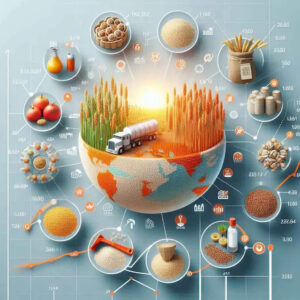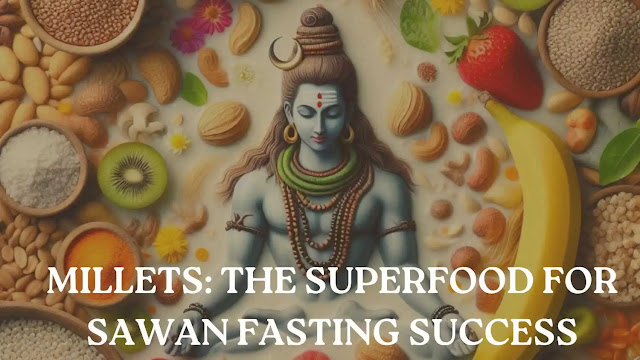Boosting Farmers’ Income: Harnessing Brown Top Millet for Sustainable Agriculture
 |
| Harnessing Browntop Millets for Sustainable Agriculture |
The world is constantly confronted with issues of agriculture and nutrition. In this era of therapeutic foods, millet has gained widespread recognition as a superfood. Of all the millet varieties, brown millet is one of the most unusual and least researched millet varieties of all.
It has the potential to produce high yields under the poor resources and fragile ecological conditions and ensure the economic and food security of smallholder farmers.
Brown millets are one of the various minor millets, but their importance has only recently come to light because of their enormous potential to improve our overall health. Brown millet has the highest dietary fibre content at 12.5%, which serves as a medicine to treat civilization diseases.
Brown millet is one of the rarest and least researched types of millet. This millet is not only nutritious, but also very tasty to eat. It is a gluten-free millet that is enriched with all the important nutrients and micronutrients.
Comprehensive guide for finger millet farming
Nutritional Profile of Brown Top Millet
Brown Top Millet is such a versatile grain with impressive nutritional benefits. This tiny greenish grain contains calcium, magnesium, potassium, zinc and iron, among other things.
 |
| Nutritional profile of Browntop Millet |
1. Protein:
Brown Top Millet contains about 8 grams of protein per 100 grams. Protein is necessary for tissue repair and building muscle and is needed for good all-round health.
2. Fibre:
With 9 grams of fibre per 100 grams, Brown Top Millet promotes digestive health and helps in blood sugar control. Fibre keeps a person fuller with adequate intake.
3.B Vitamins:
This millet serves as a good amount of energy-providing B vitamins, such as niacin, thiamin, and riboflavin. Such vitamins are very essential for energy production, maintaining healthy cognitive functions, and overall well-being.
4. Minerals:
Brown Top Millet is rich in vital minerals, notably magnesium, phosphorus, and iron. Magnesium plays its role well in the functioning of muscles, mainly bones, while phosphorus contributes to energy metabolism. Iron is an element that has its very critical function in red blood cell formation.
5. Heart Health:
Brown Top Millet consumption can help reduce LDL cholesterol, prevent arterial clots, and improve cardiac function. It’s a heart-healthy choice.
6. Immunity and Energy:
Such nutrient makeup in millet supports proper immune system function and energy generation. It is an excellent diet addition.
Brown Top Millet will help work toward general health and thus will prove to be a good addition to your diet. It is an ancient grain, full of taste and nutrition, whether used as a whole grain or in flour form.
 |
| How Browntop Economically boosts farmers Income |
How Browntop Economically boosts farmers Income
1.Low Maintenance crop
Brown millet is a farmer-friendly crop due to its resistance to heat, drought and flooding.
It is a hardy plant that can withstand harsh climatic conditions. It is able to spread deep and wide in the soil.
What factor hinder adoption of millet prectices
2.Short Growth Cycle and Frequent Harvests:
Brown Top Millet, also commonly referred to as Korale or Andu Korale, has a short growth cycle compared to other crops. It quickly matures, thus giving the farmer a chance to make several harvests within a single year.
More frequent harvesting offers an increased number of opportunities for generating income. A farmer can grow this millet alongside other crops and fully utilise land productivity.
3.Low Water Requirements:
Brown Top Millet is drought-tolerant, and water requirements are less compared to rice or wheat. This makes it excellent for areas that have rainfall which is erratic or where the irrigation facilities are poor.
With millets like Brown Top, farmers can lower this stress on water and still produce decent yields.
4.Adaptability to Diverse Soil Conditions:
Brown Top Millet adapts to all types of soils. It grows well on poor, sandy, or even acidic soils.
– It hence allows farmers to grow millets on marginal lands that may not support the growth of other crops. It opens up new areas for cultivation and therefore expands or diversifies their income sources.
Unveiling hidden power of red sorghum
How Cultivation of Brown Top Millet Benefits Farmers
1. Higher Incomes:
Any farmer who includes Brown Top Millet in his rotation can realise better overall income due to increased frequency of harvests and reduced input costs.
– Its economic viability prompts farmers to consider millet farming.
2.Crop Resilience:
Brown Top Millet has built-in resistance to pests and diseases, thus reducing the reliance on chemical pesticides.
It will help farmers reduce their pesticide bills and at the same time raise healthy crops.
3.Food Security and Nutrition:
– Millets are nutritious grains rich in fibre, protein, and essential minerals.
– Brown Top Millet growing will give farmers an opportunity to help raise food security by growing healthier food and better vegetables.
Brown Top Millet has its economic benefits viewed in its growth cycle, which is short, water efficient, and adaptable.
 |
| Brown top Millet for sustainable agriculture |
what is the role of Browntop Millet in sustainable Agriculture
1. Drought Tolerance and Adaptability
Millets, including Brown Top Millet, are chosen to be resilient in growing on unfriendly terrains. Their incredible drought tolerance makes them climate crops. Here’s why:
Deep Root Systems:
Millets grow very deep roots that extend deep into the soil. This root attribute helps them tap water from the lower layers during dry spells.
Low Water Demand:
Millets are highly drought-resistant and require very little irrigation unlike crops which have large water requirements. They can be grown in areas with rainfall inconsistencies.
Lower Water Footprint:
Growing millets helps farmers conserve water since these grains require an extremely small amount compared to rice or wheat.
2. Soil Health Booster
Millets play an important role in soil health from:
Nitrogen Fixation:
Certain millet varieties, such as pearl millet, form symbiotic relationships with nitrogen-fixing microorganisms. This enriches the soil with necessary nutrients.
Accumulation of Organic Matter:
Millet residues left over after harvesting add organic matter to the soil. This improves soil structure, water-holding capacity, and availability of nutrients.
Reduces Soil Erosion:
The dense growth of millet plants avoids soil erosion. Their roots bind the soil, particularly on slopes.
Millets and Sustainable Agriculture
1. Biodiversity and Rotation of Crops
Crop Diversity:
Millets in crop rotation will ensure biodiversity. This is the rupturing of the cycle between pests and diseases, which comes due to monoculture.
Nutrient Cycling:
Millets are efficient nutrient cyclers. The need for synthetic fertilisers is reduced in this crop. It is a sustainable practice, especially for soils and succeeding crops.
 |
| Millet and Sustainable Agriculture |
2. Lower Environmental Impact
Pesticide Reduction:
Millets require fewer pesticides since they are naturally resistant. This minimises the chemical runoff into ecosystems.
Carbon Sequestration:
Millet fields are carbon sinks, and excess carbon dioxide is stored in them from the atmosphere, therefore controlling climate change.
Millets are considered not only good for your health but are also resilient companions in the face of climate adversity. It is their capability to thrive in poor conditions and be more beneficial in improving soil health through the use of millet farming, which just adds to sustainable agriculture. This makes them a smart choice for farmers and the planet alike.
Value addition and branding of millet for farmers
1. Market Demand for Millet-Based Products
From the analysis above, it is evidently clear that the global millet market is registering stable incremental growth. In 2024, the global millet market was provisionally estimated at a value of USD 11.53 billion and is further expected to reach a value of USD 14.43 billion in 2029, at a compound annual growth rate (CAGR) of 4.60%.
On 32 million hectares in the world, millets, including sorghum, finger millet, pearl millet, barnyard millet, proso millet, and little millet, are grown. India, Niger, and China are by far the largest producers of millets, holding the share of more than 55.0% in global production.
Virtuous protein content of millets is expected to ensure their increase. adoption among vegetarians and vegans across the United States, Europe, and Asia-Pacific.
– People are taking interest in nutrient-rich foods such as millets especially during the pandemic, hence increasing the demands for millet products.
 |
| Value Addition opportunity for farmers |
2. Value Addition Opportunities for Farmers:
Processing: Process millets into value-added products like millet flour, flakes, and biscuits. Such processed forms are gaining visibility in the consumer market.
Branding:
Branding is another strategy for farmers to sell millets at the local level by branding local brands or branding their own millet-based farmer products. It helps in increasing market visibility and consumer trust in the product.
Regional Recipes:
Promote regional recipes containing millets. For example, breakfast cereal, granules, and innovative products could be catchy.
Exploring beauty of Millets guide
Nutritional Awareness:
Create awareness among consumers regarding the nutritional benefits of millets. Their composition of proteins, fibres, vitamins, and minerals can be assessed for customers.
Remember:
Millets are not only healthful but also sustainable for the environment. The value addition and leverage of its demand in markets will serve as a tool for the success of millets as an agri-business for farmers.
Some of the potential problems faced by millet farmers and some potential solutions include:
1. Lack of Awareness:
Problem:
Most of the farmers growing millets are unaware of proper agriculture practices related to millet farming. In most cases, a crop commonly practised attracts more attention.
Solutionets
Engage in awareness campaigns at the local and regional levels. Make the farmers understand the nutritional value of the millets, their climate resilience, and how the enterprises accord economic gain. Workshops and seminars and farmer-to-farmer field schools can best play a role in this knowledge dissemination.
2. Marketing Hurdles:
Challenge:
The millet farmers face a problem in marketing their produce. A dearth of proper channels and market linkages acts as a barrier to their incomes.
 |
| Challenges for Millets |
Solution:
– Millet-specific market places or their integration into existing markets.
– Through farmer-producer organisations to get better bargaining prices
– Tie-ups with food processing companies to develop products based on millets
– Building capacities in packaging, branding, and marketing strategies.
3. Govt. Support
Problem- Inadequate government. Policies and subsidies about the cultivation of millets hamper the growth.
Solution:
1.Advocacy with policy reforms for millets.
2.Give financial support and credit on subsidised rates.
3.Provide appropriate research through extension services for guidance on growing millets.
4.Millets should be introduced to the public distribution system together with school feeding programs.
Remember, empowering millet farmers requires a holistic approach involving education, policy changes, and market development.
Conclusion: Cultivating Prosperity
Brown Top Millet (also known as Korale or Andu Korale) holds great promise for both the farmer and consumer. How a simple grain that can be a pioneer of good fortune is elaborated below:
1.Economically support Benefits for Farmers
Brown Top Millet is a hardy crop that grows easily to diverse climates, hence being a perfect crop option that can grow by small scale farmers.
It requires very minimal water and can be cultivated under poor soil conditions, thus saving the cost inputs.
Adequate yield per acreage assures the farmer of returns to investment.
In summary, Brown Top Millet enriches the grassroots society and promotes the rural economy.
2. Nutritional Value:
To Consumers
It’s gluten-free and very nutritious since it has very high levels of iron, magnesium, and B vitamins.
It is low at the levels of glycemic index and can be consumed by even diabetics.
– The grain has antioxidants that reduce inflammation and can be consumed by patients with uric acid.
– It generally promotes good health and well being.
So,Let’s celebrate the resilience of Brown Top Millet and advocate for it to be grown. When we choose millets, it means not only nourishing ourselves but also guaranteeing sustainable agriculture and prosperity.



